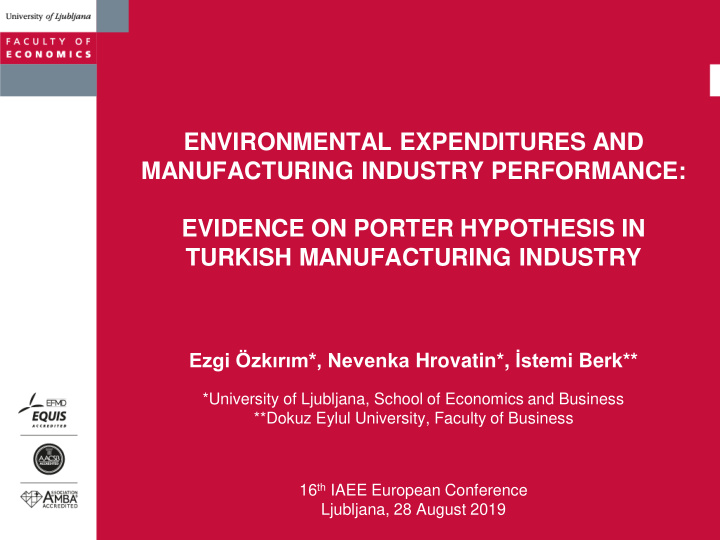



ENVIRONMENTAL EXPENDITURES AND MANUFACTURING INDUSTRY PERFORMANCE: EVIDENCE ON PORTER HYPOTHESIS IN TURKISH MANUFACTURING INDUSTRY Ezgi Özkırım*, Nevenka Hrovatin*, İstemi Berk** *University of Ljubljana, School of Economics and Business **Dokuz Eylul University, Faculty of Business 16 th IAEE European Conference Ljubljana, 28 August 2019
Outline 1. Motivation 2. Theory and Research 3. Literature Review 4. Empirical Analysis 5. Conclusion 1
Motivation (1) • Increasing economic activity and the threat of the environmental pollution • Human induced climate change and mitigation policies → Kyoto Protocol, EU2020 targets, COPs, etc. • COP21 Paris • main target: → 1.5 ◦ C above pre-industrial levels → targets of GHG emissions • Intended national determined contributions (INDCs): Turkey → 21% reduction from BAU expected 1.175 billion tons of CO2 equivalent by 2030. • Governmental regulations: regulatory pressures on the firms affect the investment decisions of individual firms and industries. • Environmental expenditures of firms tend to increase. 2
Motivation (2) Figure 1: Environmental Policy Stringency Index Increasing level of stringency Source: OECD Stats. https://stats.oecd.org/Index.aspx?DataSetCode=EPS 3
Theory and Research Porter Hypothesis (PH) suggests that stringent environmental regulation would increase both innovation and productivity (Porter and Van der Linde, 1995) • Strong PH: Environmental regulation positively affects firms‘ productivity • Weak PH: Environmental regulation positively affects innovative activities of the firms Objective of the study Testing the validity of the ‘Weak’ and ‘Strong’ Porter Hypotheses in Turkish manufacturing sector Research Question: How do environmental regulations influence innovative activities and productivity of the firms in Turkish manufacturing industry? 4
Theory and Research (2) Figure 2: Environmental Regulations vs. Firms’ Performance 5
Literature Review (1) Table 1: Summary of selected studies on Porter hypothesis: Jaffe and Hamamoto Lanoie et al. Yang et al. Rubashkina et Zhao et al. Palmer (1997) (2006) (2008) (2012) al. (2015) (2018) Variables PACE PACE PACE PACE PACE PACE R&D Patents R&D TFP TFP Growth Patents TFP TFP TFP Growth Testing Weak PH Strong and Strong PH Strong and Strong and Strong PH Weak PH Weak PH Weak PH Results Confirms/Reje Confirms Confirms/ Confirms/ Confirms weak Rejects strong cts weak PH strong and Rejects strong Rejects weak PH PH weak PH PH PH Inconclusive Confirms for strong PH strong PH Sample US Japanese Canadian Taiwanese European Carbon Manufacturing manufacturing manufacturing Manufacturing Manufacturing intense industries industries industries Industries Sectors Chinese industries 6
Literature Review (2) Summary of the results in the studies: • Mostly sectoral analysis • Variables used; • PACE is used as the main proxy for environmental regulation • TFP (both in levels and as growth) is used for strong PH • R&D and patents data are used for weak PH • Results generally confirm weak PH; inconclusive for strong PH • Endogeneity is the main concern Expected contribution of our study is two-fold: 1.Literature • contradicting results on both PHs • our study: insights from another developing economy: Turkey 2.Literature: • industry-level analyses • our study: firm level study from different manufacturing sub-sectors 7
Data Data is provided by Turkish Statistical Institute (TSI): • 1. Annual Industry and Service Statistics (2009-2015) • 2. Environmental Employment, Income and Expenditure Statistics of Enterprises (2012- 2015) • Merged data set is unbalanced panel covering 2,741 firms in 24 manufacturing industries (Section C in NACE Rev.2) for years 2012-2015. 8
Empirical Model and Variables Model Specification: 𝑧 𝑗𝑢 = 𝛽 + 𝛾𝑦 𝑗𝑢 + 𝜄𝑨 𝑗𝑢 + 𝜈 𝑗 + 𝜗 𝑗𝑢 1 Dependent variable 𝑧 𝑗𝑢 ∶ • Strong PH: either value added or labour productivity • Weak PH: intangible assets Indipendent variables: • 𝑦 𝑗𝑢 : 𝑞𝑏𝑑𝑓 • 𝑨 𝑗𝑢 : vector of control variables, such as firm ownership structure, export/import intensity and electricity consumption 𝜈 𝑗 : individual fixed effects 𝜗 𝑗𝑢 : idiosyncratic error term 9
Descriptive Statistics Table 2: Summary Statistics of Variables under consideration 10
Testing Strong PH - Empirical Results (1) • Dependent variable: value added (proxy for productivity*) • Hypothesis: positive effect of PACE on the value added • Estimator: Fixed Effects (Hausman Stat.) Table 3: Findings with Unbalanced panel of 2741 firms 11 *Results are robust when lab_prod is used instead of value-added.
Testing Weak PH - Empirical Results (2) • Dependent variable: intangible assets (proxy for innovation) • Hypothesis: positive effect of PACE on innovation • Estimator: Fixed Effects (Hausman Stat.) Table 4: Findings with Unbalanced panel of 2741 firms 12
Treatment of Endogeneity (1) Possible causes of endogeneity: • bidirectional causality: value added vs. pace • omitted factors: response vs. deliberate • measurement errors: self-reported expenditures (Rubashkina et al., 2015; Zhao et al. 2018) Selection of instrument(s): for firm i in subsector ത 𝑙 ∈ 𝑙 𝑞𝑏𝑑𝑓 • (IV1) ( 𝑤𝑏𝑚𝑣𝑓_𝑏𝑒𝑒𝑓𝑒 ) −𝑗, ഥ 𝒍 average share of PACE intensity for all other firms that are in the same manufacturing subsector ഥ 𝒍 as firm i 𝑞𝑏𝑑𝑓 • (IV2) ( 𝑤𝑏𝑚𝑣𝑓_𝑏𝑒𝑒𝑓𝑒 ) −𝑗,𝒍 average share of PACE intensity all other firms in all sectors including subsector ഥ 𝒍 13
Treatment of Endogeneity (2) Strong PH First Stage Results Table 5: Strong PH – Productivity IV regression – first stage results 14
Treatment of Endogeneity (3) Strong PH Second Stage Results Table 6: Strong PH – Productivity IV regression – second stage results 15
Treatment of Endogeneity (4) Weak PH First Stage Results Table 7: Weak PH – Innovation IV regression – first stage results 16
Treatment of Endogeneity (5) Weak PH Second Stage Results Table 8: Weak PH – Innovation IV regression – second stage results 17
Conclusions • negative and significant effect of PACE on value-added → contradicting the Strong Porter Hypothesis → environmental regulations negatively effects productivity of manufacturing firm s • insignificant effect of pace on intangible assets investment → rejecting the existence of Weak Porter Hypothesis → environmental regulations do not foster innovation • redesign of regulatory policies → more inclusive → benefit rather than a burden 18
Recommend
More recommend